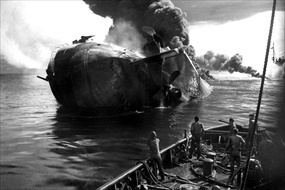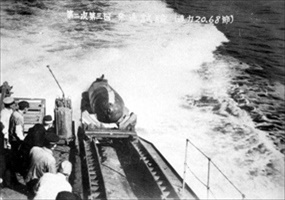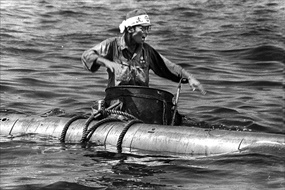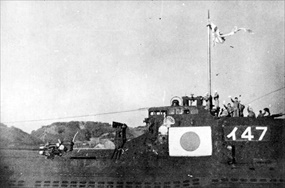JAPAN DEPLOYS SECOND KAITEN ATTACK FLEET
Ulithi Atoll, Caroline Islands, Western Pacific • January 9, 1945
Toward the end of 1943, the Japanese high command in Tokyo recognized the unfavorable progress of the war that shrank their nation’s watery outer defense perimeter closer and closer to the 4 Home Islands themselves as the Allies seized one Pacific island after another. Seemingly overnight Allied airfields and supply bases appeared where none had existed before. One famously desperate reaction by the enemy was to recruit one‑way pilots of aircraft (Kamikaze), human-guided bombs (Ohka), and suicide boats (Shinyo) and single‑man mini-submarines (Kaiten).
The seeds of the Japanese Navy building a fleet of no-return mini-submarines, or Kaiten (often translated “Turn the Heaven” or “Turn of Heaven’s Will”), were sown in mid‑1944. The very first Kaiten, a Type 1, was not much more than a Japanese Type 93 (“Long Lance”) torpedo warhead and engine compartment attached to a cylinder that would become the pilot’s compartment and Kaiten’s afterbody. In all there were 7 types (or classes) of Kaitens, but only the Type 1 saw operational deployment. The Type 10, different from all other Kaitens, was based on the submarine-launched Type 92 torpedo and carried a warhead one‑fifth the size of a Type 1. Just one prototype and 2 or 6 Type 10s were built. As for the Type 1, approximately 330 were built, of which more than 100 were sent on one‑way missions.
Type 1 vessels weighed in at 8.3 long (Imperial) tons/8.4 metric tons, had a length of 48 ft 5 in/14.75 m, and a diameter of 3 ft 3 in/1 m. Type 1s carried a 3,420 lb/1,550 kg warhead. Kaitens were launched from the decks of submarines (21), destroyers (14), and a single light cruiser. The first deployment of Type 1 Kaitens—the Kikusui group, so named for kiku (chrysanthemum) and sui (water)—was launched by mother submarines I‑36 and I‑47 on November 20, 1944, outside Ulithi’s large, 212‑sq. mile/549‑sq. km lagoon. Up until early 1945 Ulithi Atoll was the U.S. Navy’s largest forward supply, replenishment, and repair base in World War II. One of I‑47’s Kaitens inside the Ulithi lagoon dispatched the U.S. fleet oiler Mississinewa and 63 men to a watery grave (see photo essay). All 8 pilots and Kaitens were lost in this initial deployment of Japan’s newest Kamikaze weapon.
The second deployment of Kaitens, known as the Kongo (“Steel”) group, occurred on this date, January 9, 1945. Mother sub 1‑36 made a repeat visit to Ulithi on January 12, her Kaitens sinking an infantry landing craft (3 deaths) and damaging a destroyer (8 casualties). 1‑36’s November 1944 compatriot I‑47 launched 4 Kaitens off Hollandia on the north coast of New Guinea (part of the then Dutch East Indies) and missed scoring a second sinking by only damaging a 7,247‑ton Liberty cargo ship.
Four more members of the Kongo group fared poorly. Kaiten carrier I‑48 took I‑47’s former place at Ulithi but went down with all 122 hands when sunk by a U.S. Navy destroyer. Mothership I‑53 managed to launch 4 Kaitens off Kossol Roads, a large reef-enclosed anchorage in the Palau island chain that was used successively by Japan and the U.S. as a fleet anchorage. None of the 4 reached its target; indeed, 2 failed to travel any distance at all. Mothership I‑56 embarrassed herself and Japanese Emperor Hirohito (posthumously referred to as Emperor Shōwa) by failing to reach her target, Seeadler Harbor on Manus Island in northern Papua New Guinea, returning home with her full complement of Kaitens. Finally, mothership I‑58 launched all 4 Kaitens off Apra Harbor, a deep-water U.S. naval base on Guam, only to have 1 Kaiten explode immediately after launch and the other 3 disappear in pillars of smoke off in the distance along their general bearing.
The Kaiten Human Torpedo—Japan’s Newest Kamikaze Weapon
Above: Of the 7 Kaiten type classes, only the Type 1 was used operationally. The Type 1 had a maximum range of 42 nautical miles/78 km and sped through the water at speeds between 5.1 kn/9.5 km/h (minimum) and 30 kn/56 km/h (maximum). Kaitens turned out to be a pipe dream of Japanese Navy brass as a way of staving off the nation’s inevitable defeat. The human-guided torpedoes sent just 3 U.S. ships to the ocean floor between November 20, 1944, and mid-August 1945, when Japan’s emperor capitulated to the Allied victors. During the same period at least 106 Kaiten pilots died in their Kaiten coffins attacking U.S. ships and a further 15 in training mishaps. Eight hundred sailors perished when their mother subs were sunk. For every 4 Japanese who died in Kaitens or in mother subs, 1 American died.


Left: The U.S. auxiliary fleet oiler Mississinewa, at anchor in the Ulithi lagoon, was sunk on the morning of November 20, 1944, by a Kaiten launched from I‑47 just outside the lagoon. Ulithi coral reef lagoon in the Western Pacific Caroline archipelago could accommodate over 700 ships with plenty of room for refueling, repair, maintenance, and storage operations. The Kaiten attack was the first successful attack by Japan’s kamikaze mini-subs. The Mississinewa’s cargo tanks were filled nearly to the brim with 404,000 U.S. gallons/1,529,306 liters of aviation gas, 9,000 barrels of diesel fuel, and 90,000 barrels of fuel oil. The explosion of the Kaiten’s warhead in the front starboard bow area rocked the oiler. A second explosion occurred when an aviation gas cargo tank ignited. Fires reached the after magazine and caused yet another explosion. Flames towered 100 ft/30 m over the wounded ship. A little over 4 hours later the oiler slowly rolled over on its port side and disappeared beneath the oily surface, taking with it 63 hands out of 299 officers and enlisted men.
![]()
Right: Most of the Type 1 Kaitens were sent into combat by 21 submarines. A smaller number of launch vessels (14) were destroyers and a single light cruiser. Destroyers and the light cruiser Kitakami could accommodate 8 Kaitens, 4 on the port side and 4 on the starboard. Submarines accommodated 4 Kaitens. The Kaitens were tested at Kure Naval Arsenal near Hiroshima. The naval arsenal lay on the Seto Inland Sea as did the Sasebo Naval Arsenal. A series of emergency repairs owing to a British torpedo attack in late January 1944 forced the Kitakami to Sasebo Naval Arsenal later in August for repairs and modification into a human torpedo carrier. The refit was completed 5 months later, after which the cruiser was assigned directly to the Imperial Navy Combined Fleet, home port Kure, to train Kaiten pilots in the Seto Inland Sea as shown in this photograph. This late in the war fuel shortages limited the cruiser’s training sorties.
 |  |
Left: A volunteer Kaiten pilot in training maneuvers wears a white silk hachimaki around his head. The great majority of Kaitens were Type 1 Kaitens and were based on Japan’s successful Type 93 “Long Lance” torpedo, which burned ethanol or methanol. The photograph above may depict this samurai warrior wrestling with a Type 10 Kaiten, which was built around a Type 92 electric torpedo. Only 1 prototype and 2 or 6 were ever produced. The Type 10 Kaiten was tiny compared to Type 1 Kaitens. Entered through an upper, not lower, hatch, the Type 10 Kaiten at 2.3 ft/0.7 m in diameter—impossibly cramped, stifling, and uncomfortable for the pilot and plagued by seawater leaks into the battery compartments and pilot’s compartment—carried a warhead just a fifth the size of a Type 1 Kaiten. Nevertheless, the Japanese Naval command ordered construction of more than 500 Type 10s.
![]()
Right: Commissioned in July 1944, I‑47 operated as a Kaiten human-piloted torpedo carrier during the final year of the Pacific War. I‑47 was 1 of 2 mother submarines that composed two-thirds of the Kikusui-tai Kaiten (“Floating Chrysanthemum”) trio assigned to mount the first Kaiten operation of the war—in the case of I‑47 and I‑36 on the U.S. anchorage at Ulithi Atoll in the Caroline Islands. I‑37, the third member of the Kaiten operation, came to grief off the Philippine island of Leyte, its objective, on November 19, 1944. Three days earlier, on November 16, Japanese reconnaissance aircraft had made a high-altitude flight over Ulithi Atoll and sighted 4 fleet aircraft carriers and 3 battleships as well as many cruisers and destroyers in the north-central part of the lagoon and transports, oilers, and other ships in the south-central part. In fact over 200 ships were at anchor in the lagoon that week. On November 20, 1944, between 3:28 and 3:42 a.m., I‑47 launched its Type 1 Kaitens. I‑36 managed to launch 1 Kaiten, which a U.S. warship sank. At 5:47 a.m. a single Kaiten from I‑47 rammed the hull of U.S. Navy fleet oiler Mississinewa, which caught fire, capsized, and sank at 9:28 a.m. After examining after-action reports and post-attack reconnaissance photographs, the Japanese mistakenly credited the Ulithi attack with sinking 3 aircraft carriers and 2 battleships when only a fleet oiler was sunk. Radio Tokyo declared the Ulithi attack a rip-roaring success.
Kaiten: Japan’s Crewed Attack Torpedo and Suicide Craft, 1944–1945
![]()

 History buffs, there is good news! The Daily Chronicles of World War II is now available as an ebook for $4.99 on Amazon.com. Containing a year’s worth of dated entries from this website, the ebook brings the story of this tumultuous era to life in a compelling, authoritative, and succinct manner. Featuring inventive navigation aids, the ebook enables readers to instantly move forward or backward by month and date to different dated entries. Simple and elegant! Click
History buffs, there is good news! The Daily Chronicles of World War II is now available as an ebook for $4.99 on Amazon.com. Containing a year’s worth of dated entries from this website, the ebook brings the story of this tumultuous era to life in a compelling, authoritative, and succinct manner. Featuring inventive navigation aids, the ebook enables readers to instantly move forward or backward by month and date to different dated entries. Simple and elegant! Click 











